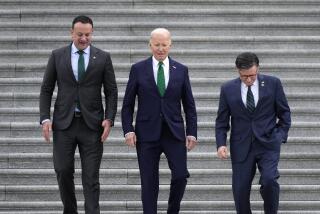U.S. Money Supply Rises $1 Billion
- Share via
NEW YORK — The nation’s basic money supply rose $1 billion late last month, the Federal Reserve Board said Thursday in reporting an increase that left growth in M1 above target.
The Fed said M1 increased to a seasonally adjusted $639.3 billion in the week ended March 24 from $638.3 billion in the previous week.
For the latest 13 weeks, M1 averaged $631.2 billion, a 7.8% seasonally adjusted annual rate of gain from the previous 13 weeks. M1 represents funds readily available for spending, including cash in circulation, deposits in checking and certain other liquid accounts.
The Fed has said it would like to see M1 grow in a range of 3% to 8% from the fourth quarter of 1985 through the final quarter of 1986.
So far in March, M1 was expanding at about a 13% annual rate. But analysts weren’t troubled by the double-digit clip.
IRS Processing Cited
Raymond W. Stone, chief financial economist at Merrill Lynch Capital Markets in New York, linked last month’s M1 growth to the Internal Revenue Service processing personal income tax returns faster than it did last tax season. People receiving their refund checks from the IRS are depositing them in NOW accounts and the like--temporarily bloating M1, he said.
Fed officials, as they attempt to promote non-inflationary economic growth, seem to be paying less attention to the narrow money measure than to broad economic trends.
“I would be reluctant to say M1’s March growth is significant in terms of the conduct of monetary policy. The Fed has enough distrust of the behavior of M1 that they are not going to react,” Stone said.
It is believed by many analysts that the collapse in world oil gives the Fed greater flexibility in formulating monetary policy.
With cheap oil holding inflation down, the policy-makers needn’t worry as much about inflation flaring up if economic growth accelerates.
The Federal Open Market Committee, the Fed’s policy-making arm, met this week to set strategy for the spring, and some analysts think the panel decided to become more generous with credit if the economy remains lethargic as the spring proceeds.
John Rutledge, chairman of Claremont Economics Institute in Claremont, is one analyst who believes that the authorities favor easier credit conditions.
“The growth signs on the economy aren’t all that hot. I think they are very concerned about the strains on banks and other corporations from the dramatic weakening in petroleum prices,” Rutledge said.
In other reports:
- The Federal Reserve Bank of New York reported that commercial and industrial loans on the books of major New York City banks fell $709 million in the week ended March 26, compared to a gain of $92 million a week earlier.
- The Federal Reserve Bank of St. Louis reported that the monetary base--the seasonally adjusted total of member bank reserves held at Federal Reserve banks and cash in bank vaults and in circulation--was $239.1 billion in the two weeks ended March 26, up from $238.8 billion in the previous two weeks.
- The Federal Reserve said bank borrowings from the Federal Reserve System averaged $234 million in the two weeks ended March 26, up from $229 million in the prior two weeks.
- The Federal Reserve said commercial paper outstanding nationally fell $937 million in the week ended March 26, bringing the total to $300.1 billion. A week earlier, these corporate IOUs rose $928 million.
- The Federal Reserve said total adjusted reserves of member banks averaged $46.6 billion in the two weeks ended March 26, up from $45.9 billion in the previous two-week period.
- The Federal Reserve said net free reserves totaled $790 million in the two weeks ended March 26, up from free reserves of $738 million in the previous two-week period.
More to Read
Inside the business of entertainment
The Wide Shot brings you news, analysis and insights on everything from streaming wars to production — and what it all means for the future.
You may occasionally receive promotional content from the Los Angeles Times.










